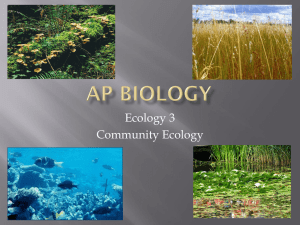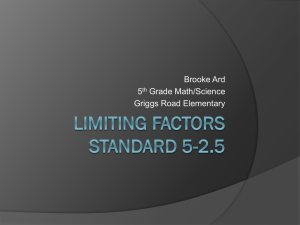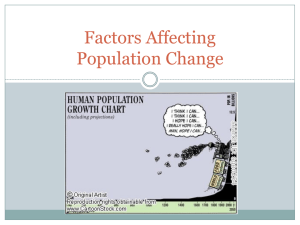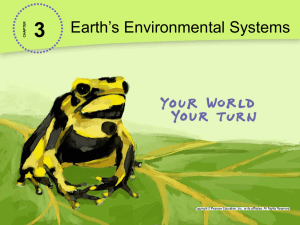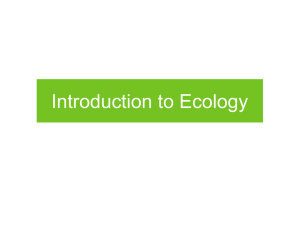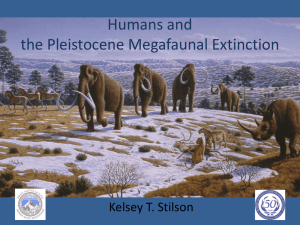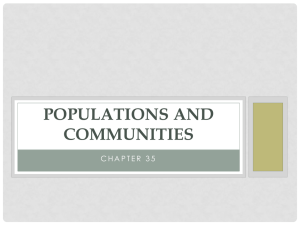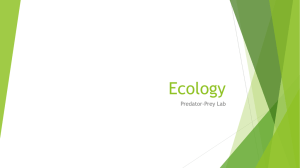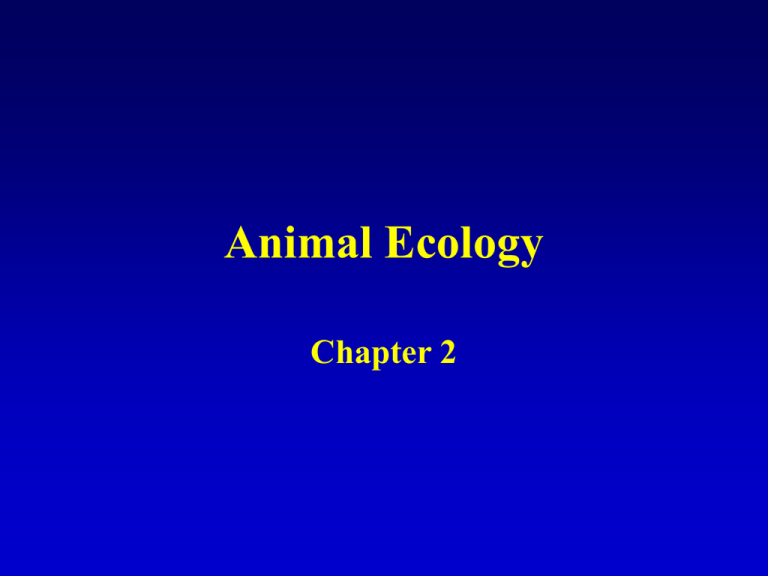
Animal Ecology
Chapter 2
Ecology
• Ernst Haeckel introduced the term
ECOLOGY defined as the relation of
animal to its organic as well as inorganic
environment.
The Hierarchy of Ecology
•
•
•
•
•
Organism
Population
Community
Ecosystem
Biosphere
The Hierarchy of Ecology
• Organism: Is the base of the ecological
hierarchy.
• Population: a group of animals coexist with
others of the same species.
• Community: Populations of different
species co-occur in more complex
associations.
Communities
• The complexity of a community is measured
as species diversity.
• Species diversity: is the number of different
species that coexist to form the community.
– Predation, competition, parasitism, and
mutualism.
The Hierarchy of Ecology
• Ecosystem: An ecosystem consists of all
populations in a community together with
their physical environments.
• Biosphere: The largest ecosystem.
Environment and Niche
Environment and Niche
• Environment: includes the abiotic
(nonliving) factors, and biotic (living)
factors.
Environment and Niche
• Environment: includes the abiotic (nonliving)
factors, and biotic (living) factors.
• Niche: a multi dimensional relationship of species
with its environment.
– Fundamental niche: is the potential niche
– Realized niche: the subset of potentially suitable
environments that an animal actually experiences.
Figure 2.2 p 37
Populations
• Population: a reproductively interactive
group of animals of a single species
– A species may be a single, cohesive population
or may contain many geographically disjunct
populations, often called demes.
– Members of a deme interbreed, and therefore
share a common gene pool.
Metapopulation
• Refers to a population subdivision into
multiple genetically interacting demes.
– Gene flow can be symmetrical or asymmetrical
– In asymmetrical demes you can have source
and sink demes
Population Demography
• Age structure: cohort and survivorship
• Sex ratio: sexual reproduction, cloning,
unitary, parthenogenesis
• Growth Rate
Survivorship
• Cohort: individuals born at the same time.
• Survivorship: measures the survival of
individuals in a population from birth to
death of the last member of a cohort.
– There are three principle types of survivorship
curves, they are referred to as I, II, and III.
Figure 2.4 p 39
Birds
Inverts,
fish, frogs
Figure 2.4 p 39
Humans
Birds
Inverts,
fish, frogs
Figure 2.4 p 39
Population Age Structure
• Some animals such as insects and many
invertebrates reproduce only once before
they die.
• Other animals such as mammals and many
vertebrates survive long enough to
reproduce multiple times.
– These groups of animals exhibit age structure.
Figure 2.5 p 39
Population Growth and Intrinsic
Regulation
• Population growth = birth rate – death rate.
• All populations have an inherent ability to
grow exponentially, this is the intrinsic rate
of increase (r).
Population Growth and Intrinsic
Regulation
• Although all populations have an inherent
ability to grow exponentially, there are
limited resources in the environment.
• These limited resources in the environment
create a carrying capacity (K) on
populations of animals.
Figure 2.6 p 40
Carrying Capacity
• In reality populations of animals fluctuate
around the carrying capacity, these are
known as oscillations.
Figure 2.7 p 41
Why do populations Oscillate
around the K?
Why do populations oscillate around
the K?
1) The carrying capacity of an environment
can change over time.
Why do populations oscillate around
the K?
1) The carrying capacity of an environment
can change over time.
2) Animals always experience a lag between
the time that a resource becomes limiting
and the time that the population responds
by reducing its rate of growth.
Why do populations oscillate around
the K?
1) The carrying capacity of an environment
can change over time.
2) Animals always experience a lag between
the time that a resource becomes limiting
and the time that the population responds
by reducing its rate of growth.
3) Extrinsic factors (other biotic and abiotic
factors).
Figure 2.7 p 41
Extrinsic Limits of Population
Growth
• Two Types of Extrinsic Factors
Extrinsic Limits of Population
Growth
• Two Types of Extrinsic Factors
– Density-independent: these are abiotic limiting
factors (frost kills all the mosquitoes)
Extrinsic Limits of Population
Growth
• Two Types of Extrinsic Factors
– Density-independent: these are abiotic limiting
factors (frost kills all the mosquitoes)
– Density-dependent: These are biotic limiting
factors (competition, predators and parasites)
Community Ecology
• Populations of animals that form a
community interact in three ways.
– Detrimental (-)
– Beneficial (+)
– Neutral (0)
Types of interactions
• Predator/prey and parasite/host (+,-),
coyote/rabbit; tapeworm/coyote.
• Commensalism (0,+), pilot fishes and
remoras with sharks.
• Mutualism (+,+) termites and gut protozoa.
Competition
• Sometimes competition between species
reduces fitness of both species, (-,-).
• Sometimes the effect on one species in a
competitive relationship is negligible, (0,-)
amensalism or asymmetric competition. (eg.
Barnacles)
Competition
• Usually in nature competition is more
complex when more than two species are
competing for resources.
Competition and character
displacement
• Competition only occurs when two or more
species share a LIMITING resources not
just sharing resources.
Competition and character
displacement
• Niche overlap: the portion of resources
shared by the niches of two or more species.
Competition and character
displacement
• Niche overlap: the portion of resources
shared by the niches of two or more species.
• Competitive exclusion: strongly competing
species cannot coexist indefinitely.
Competition and character
displacement
• Niche overlap: the portion of resources shared by
the niches of two or more species.
• Competitive exclusion: strongly competing species
cannot coexist indefinitely.
• In order to coexist in the same habitat, species
must specialize by partitioning a shared resource,
this is known as character displacement.
Figure 2.10 p 44
The ghost of competition past
• The absence of competition today.
Guilds
• When several species share the same
general resource by partitioning resources
they are known as a guild.
Robert MacArthur
• Studied five species of warblers in spruce
woods of the northeastern U.S.
• The five species of birds look vary similar in
size and appearance.
Robert MacArthur
• Studied five species of warblers in spruce
woods of the northeastern U.S.
• The five species of birds look vary similar in
size and appearance.
• How can they coexist?
Figure 2.11 p 45
Predators and Parasites
• Predators and prey and parasites and hosts
to some degree cause coevolution.
• Predators get better at catching prey and
prey get better at escaping predators.
Predators and Parasites
• Most predators feed on more than a single
species.
• However, when a predator relies primarily
on a single prey species, both populations
tend to fluctuate cyclically.
Figure 2.12 p 45
Predator Prey Interactions
Defenses by potential prey
• Distasteful prey and warning coloration.
Defenses by potential prey
• When palatable prey adopt warning
coloration this is an advantage for the prey
and deceit for the predator.
Defenses by potential prey
• Batesian mimicry: Palatable prey can
deceive potential predators by mimicking
distasteful prey.
• Müllerian mimicry: Two or more toxic
species resemble each other.
Figure 2.13 p 46
Keystone Species
• An influential species on other species that if
it is absent it drastically changes an entire
community.
Figure 2.14 p 47
Ecosystems
• Transfer of energy and materials among
organisms within ecosystems is the ultimate
level of organization in nature.
• Productivity: incorporation of material and
energy into biological systems.
Trophic Levels and Food Webs
• Primary Producers: fix and store energy
from outside the ecosystem (photosynthetic
organisms).
• Consumers: herbivores eat plants directly;
decomposers bacteria and fungi.
• Carnivores: eat other animals.
Figure 2.15 p 49
Food chains in terms of Pyramids
• Ecological pyramids or Eltonian pyramids:
depict numbers of organisms transferred
between each trophic level. Units can be
numbers, biomass or energy.
Fig. 2.16 p 51
Nutrient Cycles
• All elements essential for life are derived from
environmental air, soil, rocks, and water
(nutrients).
• These nutrients are released and returned to the
environment when the organism dies.
• Therefore nutrients flow in a perpetual cycle
between biotic and abiotic components of an
ecosystem, this is called a biogeochemical cycle.
Figure 2.17 p 52
Nutrients recycled, energy flow is one way!
The Big Picture
• Ecology is the study of living organisms and
their interactions with the environment and
other living organisms.
• Ecology has a hierarchy of organization.
• Different types of interactions occur at the
population, community or ecosystem level.

